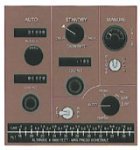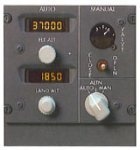Cabin Pressurization
Your aircraft, and cabin pressurization, has been climbing as the outside pressure has been falling and the temperature is getting colder. At 35,000 feet and above, the temperature can get to -70 degrees Fahrenheit. The atmospheric pressure falls from 14.7 pounds per square inch (PSI) at sea level, to about 4 PSI at altitude. Cabin pressure is usually allowed to climb gently to an automatic or manually preset altitude. This climb (and descent) rate is usually 300-500 feet per minute. For example, the Boeing 737's cabin altitude can climb to 8000 feet while the aircraft's actual altitude is 41,000 feet. Maximum cabin pressure differential (difference between inside and outside presssures) can be 8.35 PSI.

|

|

|
| Analog Control Panel | Digital Control Panel | Cabin Pressure Control Panel |
The aircraft is pressurized by bleed air from the engines which is distributed by the air conditioning system. The cabin pressurization and ventilation is controlled by opening and closing of outflow valves. This system pumps air into your aircraft that is adequately sealed to limit the rate at which this air escapes from the airplane cabin. Air pressure is increased to produce a cabin environment equivalent to one encountered at lower altitudes.
Most airline aircraft have a maximum cabin altitude of 8000 feet above sea level, with a humidity level of 4-6%. Newer aircraft, such as the Boeing 787 are being designed to have lower cabin altitudes of 6000 feet, with a humidity level of around 15%. Most airline aircraft also have High-Efficiency Particular Air (HEPA) filters and ozone scrubbers.
Some people have problems with this cabin pressurization, especially if they have had sinus-related conditions before the flight. Normally, the Eustachian tubes in your ears are open, allowing pressure to equalize between the outer and middle ear. If the Eustachian tube is blocked, middle ear pressure is higher than outside and the eardrum bulges outward while the aircraft climbs. On descent, if the Eustachian tube is blocked, middle-ear pressure is lower than the outside and the eardrum bulges inward that may cause you pain. Swallowing, yawning, or chewing gum can help keep your Eustachian tubes open. If you have a baby, the best thing would be to try to feed a bottle as this could accomplish the same thing.
Cabin Pressurization back to Enroute
Cabin Pressurization back to My Airline Flight